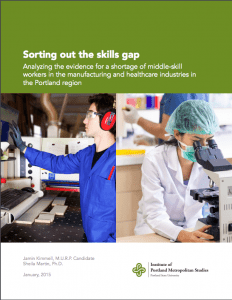The Skills Shortage Solution to Date: Panic!
There has been much publicity and alarm surrounding the impending shortage of skills in manufacturing. Evidence of the skills shortage has been raised through the analysis of survey results and deduced from the exiting of an aging workforce.
Rather than focus on the skills shortage, I’d like to offer another perspective in which persistent unemployment in the manufacturing sector is more likely driven by an inadequate demand for jobs then by any form of skills mismatch.
Manufacturing jobs have developed an unfortunate and undeserved stigma based on outdated and incorrect assumptions about compensation, working conditions, opportunities for advancement and job security.
A New Perspective for Proactive Manufacturers
Consider that there may be a sufficient number of skilled workers available, but manufacturing recruiting strategies are not effective at identifying or persuading workers to apply. Likewise, manufacturers may require unreasonably high standards of work experience or certification that screen out candidates who could be successful with a small amount of training. Additionally, many organizations may look for the “perfect candidate” who requires no training because they fear that investments in training will be lost if the employee leaves the company.
If shortages of skilled production workers are as severe as those reported by some surveys, then we would expect wages to increase for these occupations, following the basic principles of supply and demand – which is not necessarily the case.
Let’s take a look at the skills that are mainly lacking. The Economic Policy Institute asserts that, The skills needed for 62% of manufacturing jobs are basic reading skills, basic writing skills and basic math skills.
The other 38% of manufacturing firms require extended math skills such as algebra, geometry and trigonometry. This level of math can be expected from a good high school or at most a community college education.
 Locally a recent study at PSU uncovered similar trends to the skills required and further reports that the overwhelming majority of production jobs do not require any education beyond a high school diploma. Interestingly enough, in the Portland region, manufacturing has less difficulty filling jobs than does the average of the other industries.
Locally a recent study at PSU uncovered similar trends to the skills required and further reports that the overwhelming majority of production jobs do not require any education beyond a high school diploma. Interestingly enough, in the Portland region, manufacturing has less difficulty filling jobs than does the average of the other industries.
Survey Data May Not be Reliable
As I stated earlier, much of the data driving the perception that there is a skills shortage stems from surveys. The way in which the metrics are gathered can be questionable in their design, leaving much room for interpretation. For instance, one of the most common methods of measuring skill gaps is to survey managers and executives and ask questions such as,
“Is there a shortage of workers?”
“Do they have difficulty filling job vacancies?”
Interpretations of “difficulty” and “shortage” can vary considerably across respondents. The answers from the surveys are used as hard data to determine future workforce issues. In general, survey efficacy is challenged because the questions asked leave much room for interpretation, suggesting that the skills gap is based on the perceptions of executives. A survey developed and designed at MIT with the goal of removing survey bias showed that 16% of all surveyed thought that a lack of skills would indeed impact their growth. Additionally, surveys do not isolate the underlying cause of firms hiring challenges and do not help ascertain the things that manufacturers can do to close the gap.
Over the last three decades, in-house training and apprenticeship programs have steadily declined across the industry. Many of these programs were cut for budgetary reasons. Apprenticeships have decreased 50% over the last 10 years with a 35% decrease in GDP spending towards instruction.
What Can Manufacturers Do?
Manufacturers need to embrace their uniqueness and realize that it’s not up to schools or other entities to train their employees. Creating in house training to bring entry level personnel in and provide training and career development throughout the organization mitigates risks to any perceived skills shortage and just makes plain sense to remain competitive.
Persistent unemployment in the manufacturing sector is more likely driven by inadequate demand for jobs then by any form of skills mismatch.
In light of all the evidence perhaps the skills shortage needs to be reassessed as a training and attraction issue.




